Enter now to win a copy of
The Widowed Ones: Beyond the Battle of the Little Bighorn
Everyone who enters will win!
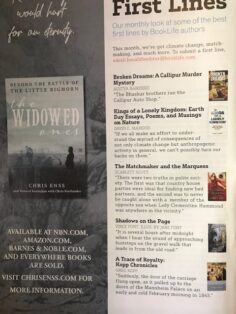
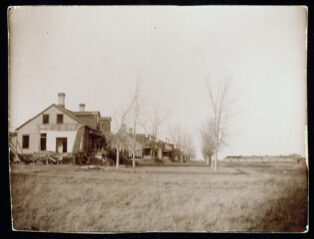
While Elizabeth and the other widows were preparing for their moves from Fort Lincoln, reporters were swarming around the home of the Custer men. All were hoping for a statement about the charge circulating in Washington, D. C., and in many newspapers that Custer’s ego and desire for fame had placed his men in danger, men that would have blindly followed him anywhere, and ultimately cost them their lives.
“They should not have said so,” the distressed Reverend Custer stated. “I am his father, and shouldn’t a father know the characteristics of his own son? He was neither proud nor vain. He fought to whip and not for praise. He was not reckless. He had much to live for, and he would not throw his life away. They shouldn’t have said so.”
When newspapers carrying the reverend’s comments reached the post, Elizabeth and the other widows were upset. The insinuation that Custer was impetuous and reckless and that those officers who served with him were incapable of independent thought was infuriating and disrespectful to the memory of their late husbands. The officers’ widows occasionally gathered on the porch of the Custers’ home to discuss the way the press was reporting on the tragic event. Weeks after the battle, none of the women had been told the specifics of the deaths of their spouses. No military official who had that information considered it necessary to share. It was determined by the post commander that Eliza Porter did not need to know just yet that her husband James’ body had been horribly mutilated and that his head had not been recovered. For the time, Grace Harrington, one of the officers’ widows at Fort Rice, was spared the news that her husband Henry’s body could not be identified and was presumed missing. Nettie Smith had no idea her husband Algernon had been wounded prior to the final battle on what would become known as Last Stand Hill. Molly McIntosh did not know her husband Donald was wrestled from his saddle and tomahawked to death, then dragged to the riverbank and scalped from forehead to neck. Maggie Calhoun and Annie Yates were unaware the bodies of their husbands, James and George, were badly decomposed by the time they were buried in a shallow grave. Elizabeth had yet to know that Custer suffered several gunshot wounds, including one to the left temple.
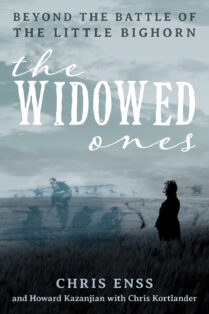
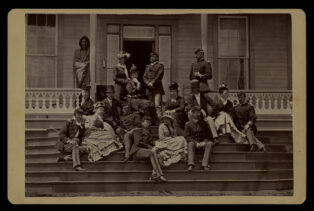
On Saturday, May 27, 1876, Henrietta “Nettie” Smith, her good friend Elizabeth Custer, and several other soldier’s wives made their way to the steamship Far West, docked in the waters near Fort Lincoln. They were excited and filled with purpose. They planned to persuade the ship’s captain, Grant Marsh, to transport them up the Missouri, to the Yellowstone River near where their husbands were camped. The wives of the Seventh Cavalry officers had met with their spouse in the field before, some living in tents with them while they performed their duties, so the request wasn’t out of the ordinary. When the troops had marched away from the fort a mere nine days prior, the goodbyes had been emotional and touching Nettie Smith, who had been married to Lieutenant Algernon Smith for more than nine years, was desperate to see him again. A sense of fear and foreboding over his safety had overtaken her and letters he had written assuring her he was fine could not convince her he was well.
Far West crew members welcomed the women aboard the vessel and as per the custom, Captain Marsh ordered a meal prepared for them. Nettie, Elizabeth, and the other wives were escorted the ship’s dining room where they were served “as dainty a luncheon as the larder of the board could afford.” Elizabeth requested the captain join them and he reluctantly did so. He was busy preparing the steamship to rendezvous with the Seventh Cavalry. He and his thirty-man crew were loading the vessel with food, ammunition, and other supplies the troops would need. There wasn’t a moment to spare.
After listening patiently to the officer’s wives request, Captain Marsh explained that in the best of circumstances “he did not wish to be burdened with many passengers for whose safety and comfort he would be responsible.” He went on to inform the women that the anticipated voyage to the Yellowstone River to be “both dangerous and uncomfortable.” This revelation did not cause the women to change their minds about their objective. They believed their place was with their husbands wherever they were and whatever peril might lie ahead.


The town of Monroe, Michigan, was blanketed in snow on the morning of December 25, 1876. The yard in front of the Custers’ home and the street beyond resembled an unfinished painting. Much of the canvas was perfectly white, waiting for an artist’s hand to bring color into the scene. Elizabeth sat by the window in her room watching the morning light struggle through the fog and cold. At some point, she would need to get dressed and join her in-laws for breakfast, but she lacked the will to move. It was her first Christmas without her husband, and the near paralyzing grief she thought she had learned to control found her. Elizabeth turned away from the window, and her eyes settled on a framed photograph of Custer sitting on her bureau. She remembered the awful moment when she had first heard the news of his death. She would never forget the devastated look on the faces of the wives who had also lost their husbands that day. “From that time the life went out of the hearts of the women who wept,” Elizabeth wrote in her memoirs, “and God asked them to walk alone in the shadows.”
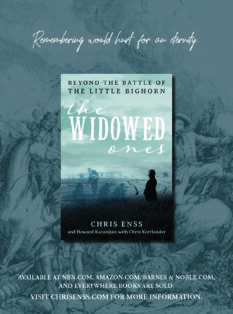

“Chris Enss and Howard Kazanjian’s inspiring history title, The Widowed Ones, is about seven women who banded together to overcome their grief. It is a compelling history text focused on women’s experiences following the Battle of the Little Bighorn.”
Foreword Clarion Review
“Readers interested in 19th-century, women’s and military history will be drawn into this thoroughly humane and sympathetic treatment of U.S. army widows.”
Library Journal
“The rigor of the scholarly research on display here is quite simply astonishing, as the authors seem to leave no stone unturned.”
Kirkus Review
“An extraordinary and inherently fascinating read from cover to cover, “The Widowed Ones: Beyond the Battle of the Little Bighorn” is an amazing and original work historical scholarship that lifts these women from an undeserved obscurity and effectively introduce them to an appreciative new generation of historians and non-specialist general readers. The true life experiences of women widowed in the aftermath of one of most famous 19th Century encounters between Native Americans and the United States military known as the Battle of Little Bighorn, “The Widowed Ones: Beyond the Battle of the Little Bighorn” is an impressively original contribution that will be enduringly valued by both academia and the general reader alike.
Enhanced with black-and-white historic photograph images, an informative Introduction, an eight page Bibliography, twelve pages of Notes, and an eight page Index, no community, college, or university library 19th Century American History can be considered comprehensive within the inclusion of “The Widowed Ones: Beyond the Battle of the Little Bighorn” into their collection.
Exceptionally well written, organized and presented, “The Widowed Ones: Beyond the Battle of the Little Bighorn” is an ideal and unreservedly recommended addition to 19th Century American Biography supplemental studies curriculums.”
Midwest Book Review
“This reviewer owns countless books on Custer and the battle at the Little Big Horn. Some are well researched. Some are well written. Few enjoy both qualities. “The Widowed Ones” scores ten in both respects.
It also presents an entirely new angle to the oft done subject matter. In other words, this is the best Custer book ever for the casual reader and the jaded western researcher. Bravo! Chris Enss. She, in collaboration with Howard Kazanjian and Chris Kortlander, gives a stunning and emotionally charged view of the women that were left behind after the historic loss of George Custer’s command in 1876.
The book weaves its way through the devastation wrought upon Libby Custer and the widowed wives of the men that wore the blue of the 7th Cavalry. Enss and Kazanjian do a terrific job detailing the women’s handling of loss; not only their husband’s demise, but also the pain of official criticism aimed to besmirch their loved ones, and their grappling with getting on with their lives without any apparent means. The path Libby et. al. took is detailed in “The Widowed Ones”, an insightful glimpse of how the survivors cope, or don’t. Each reader can measure their grit and resolute devotion to their fallen husbands. It is a marvelous story. Enss and company have filled in a neglected hole in one of the West’s greatest historical events. If you are restricted to one last book purchase, this is the one.”
Green Valley News Green Valley, Arizona
Arizona Daily Star Tucson, Arizona
Creative works by authors from two countries and 24 states have been named finalists for the 2022 Will Rogers Medallion Awards (WRMA) celebrating excellence in fiction, nonfiction, poetry, and photography of the American West. I’m honored to learn three of the books I’ve written are listed among the finalists.
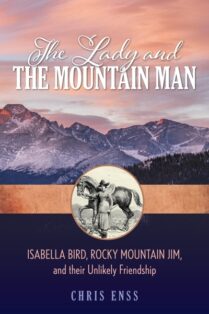
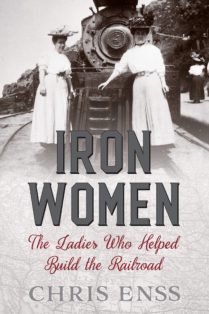
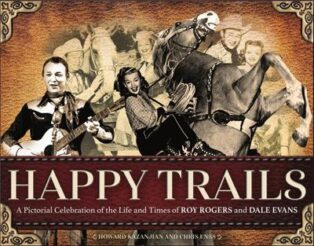

Elizabeth Custer and Annie Yates sat on the front porch of the Yates home watching Annie’s children playing in the yard. A stack of papers rested in the laps of both women, and, when they weren’t distracted by the unremarkable daily tasks of their new lives without their husbands, they sifted through the letters and government paperwork that had steadily arrived since late July 1876.
The summer of 1876 had passed slowly. The men who died at the Little Bighorn were sorely missed. Elizabeth had taken to sleeping with one of Custer’s shirts. It smelled like him, and, at night when she longed to have him near, it helped ease her pain. Annie spent evenings after the children were in bed writing letters to her deceased husband. She knew he was gone, but she had an overwhelming need to communicate with him about their little ones and the difficulty she was having moving on. Elizabeth and Annie had found unique ways to deal with their grief and by mid-fall were venturing out into public, if only to visit one another. Maggie Calhoun, on the other hand, still struggled, refusing to leave her parents’ home to even attend church. “Now that Bubbie is gone,” Maggie shared with Elizabeth about James Calhoun’s death, “…I do not feel that mentally I am fitted to fill any position of usefulness to others.”
Nettie Smith’s correspondence to Elizabeth revealed her struggle to move forward from the tragedy as well. “Last night I found a diary kept by Smithie on the Yellowstone Expedition [1873] in which so often he writes of his ‘little wife’. In one place he says, ‘These are hard marches, but it is consoling to know that we are marching toward my little wife Dudds. God bless her! Only about a month separates us.’ Oh, if that last part could only be true now. I realize the terrible truth more and more every day. Where shall we find the strength to endure?”
Some of the other officers’ widows weren’t faring any better. In early October, Elizabeth had received a letter from Eliza Porter. Mrs. Porter had returned to Maine where she and her husband James had met and married. She wanted her two sons to be near her family in Franklin County. The Porter’s first child, David, had been born in 1871 in Massachusetts, and their second boy, James, had been born in March 1876 at Fort Abraham Lincoln. Elizabeth had been with her at the birth.


Thirty-four-year-old Elizabeth Bacon Custer filed into the Methodist church in Monroe, Michigan, on August 13, 1876, with hundreds of others attending the memorial service of her husband of twelve years, General George A. Custer, and five of his officers killed at the Battle of the Little Bighorn. She was adorned in a black bombazine (silk) dress with black fringe and a black bonnet with a black crepe veil. The mourning outfit would be her standard wardrobe for years to come. She walked mechanically, but purposefully, down the center aisle, her eyes focused on a reserved seat in the front pew. Friends and acquaintances smiled piteously at her as she passed; some refrained from looking at her at all. Those who knew of her and her well-known husband by reputation only stood on tiptoe and craned their necks to watch her every move.
The heat that afternoon was sweltering. Members of the Baptist and Presbyterian churches had joined the Methodists to pay tribute to the slain soldiers who were raised in the town located on the western shores of Lake Erie. The combination of congregants along with the other funeral goers made the atmosphere in the house of worship oppressive. Halftones from the bright sun diffused through the stained-glass windows cast a colorful light on the portrait of General Custer sitting on the organ next to a magnificent podium in the very front where the pastor delivered his weekly sermons. Custer’s picture was surrounded with an evergreen wreath, and two sabers crossed underneath the picture. The names of Captain Yates and Henry Armstrong Reed were scrawled across ribbons encompassing another display in evergreen.


As Variety film critic Cecelia Ager once wrote: “There ought to be a statue erected, or a Congressional Medal awarded, or a national holiday proclaimed, to honor that great woman, Margaret Dumont, the dame who takes the raps from the Marx Brothers. For she is of the stuff of which our pioneer women were made, combining in her highly indignant Duse, stalwart oak, and Chief Fall Guy—a lady of epic ability to take it, a lady whose mighty love for Groucho is a saga of devotion, a lady who asks but little gets it.” Thankfully, there is now STRAIGHT LADY by Chris Enss and Howard Kazanjian to properly celebrate the underrated Margaret Dumont. Chris has such a gift for telling fascinating tales about fascinating women, but this is my favorite. Delightful surprises in store for the fortunate reader. Marx Brothers’ and MGM fans are going to love this book!
Michael Troyan, MGM; HOLLYWOOD’S GREATEST BACKLOT

This reviewer owns countless books on Custer and the battle at the Little Big Horn. Some are well researched. Some are well written. Few enjoy both qualities. “The Widowed Ones” scores ten in both respects.
It also presents an entirely new angle to the oft done subject matter. In other words, this is the best Custer book ever for the casual reader and the jaded western researcher. Bravo! Chris Enss. She, in collaboration with Howard Kazanjian and Chris Kortlander, gives a stunning and emotionally charged view of the women that were left behind after the historic loss of George Custer’s command in 1876.
The book weaves its way through the devastation wrought upon Libby Custer and the widowed wives of the men that wore the blue of the 7th Cavalry. Enss and Kazanjian do a terrific job detailing the women’s handling of loss; not only their husband’s demise, but also the pain of official criticism aimed to besmirch their loved ones, and their grappling with getting on with their lives without any apparent means. The path Libby et. al. took is detailed in “The Widowed Ones”, an insightful glimpse of how the survivors cope, or don’t. Each reader can measure their grit and resolute devotion to their fallen husbands. It is a marvelous story. Enss and company have filled in a neglected hole in one of the West’s greatest historical events. If you are restricted to one last book purchase, this is the one.
Columnist, Scott Dyke Green Valley News Green Valley, Arizona
